FAQS: How to Create Your Own Shave Soap Recipe {dual lye}
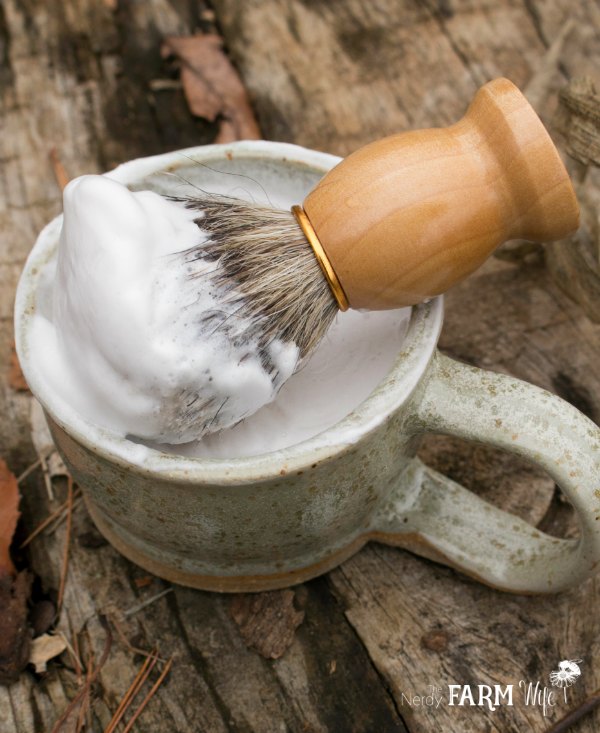
To accompany my Calendula Shave Soap Recipe, I though it’d be helpful to write up some FAQS I’ve received about how to create your own shave soap recipe.
This information is also useful to know if you want to make substitutions in an existing recipe you’ve found in a book or online and aren’t sure how to do so.
If you have a question I didn’t answer here, let me know in the comments below!
How do you use a lye calculator to create or adjust a dual lye shaving soap?
The example shown below is using Soapee’s lye calculator, which is very user friendly and a new favorite of mine.
(I’ve also used Summer Bee Meadow’s Advanced Lye Calculator in the past, though it gives different results than Soapee, possibly because the purity of KOH may not be accounted for??)
1. In the first box, choose “Hybrid Soap” and the ratio of potassium hydroxide and sodium hydroxide you’d like to use. Most potassium hydroxide is 90% purity, but double check the brand you purchased. (I use Essential Depot or Bramble Berry with good results.)
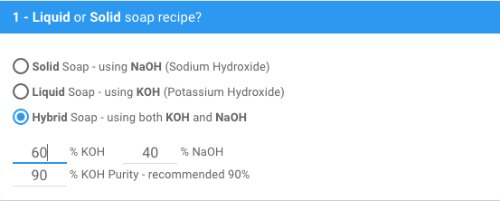
2. In the second box, choose whether you want to work in grams, ounces, etc. I’m in the US, so usually work in ounces.

3. In the third box, choose the water amount. For dual lye soaps, I choose a 5:1 ratio for simplicity, rounding the resulting water amount up if needed.

4. In boxes 4 and 5 you can choose superfat and fragrance percentage, if using. I usually input a 5% superfat and manually calculate my essential oils using my printable essential oil chart.
5. Finally, in the sixth box, you’ll select each type of oil/fat that you want to include in the recipe, click on the little + sign in the top right corner of that box, and then fill in the amount you want to use. For a 2 quart crockpot, I rarely go over 18 ounces of total oil weight because the soap will expand during cooking. (A recipe with 28 oz of oil volcanoed out onto my kitchen counter one time, so I prefer smaller batches!)

Which oils and fats should I include in my dual lye shave soap recipe?
Most important to a shave soap recipe is a high amount of stearic acid. See below for a list of ingredients high in stearic acid – these will make up the bulk of your recipe.
Stearic acid is what gives you that dense cushiony lather that’s great for shaving.
You’ll also want to include some castor oil and coconut oil to help with lather. If you’re allergic to coconut oil, try using babassu oil in its place.
Tallow is a popular additive to shave soaps for its skin conditioning qualities, or you might want to include a butter such as shea. (I’ve had less luck with mango butter in my shave soap experiments.)
You don’t need much, if any, liquid oils such as sunflower, olive, sweet almond, etc, depending on your main source of stearic acid.
For example, kokum butter contains less stearic acid than soy wax, so in my recipes, I need to use a fairly high quantity just to get a decent stearic acid number. That doesn’t leave much room for other oils.
If you use pure stearic acid flakes though, then you may have some extra room to play.
Which soapmaking ingredients are high in stearic acid?
To determine this, go to SoapCalc’s sort oils list and sort them by stearic acid. You’ll be able to see which ingredients to prioritize if your recipe needs a higher stearic acid number.
For example, if you don’t want to use kokum butter in my recipe, you could play around with soy wax or illipe butter and see what you come up with.
A high amount of stearic acid is necessary for shave soap recipes.
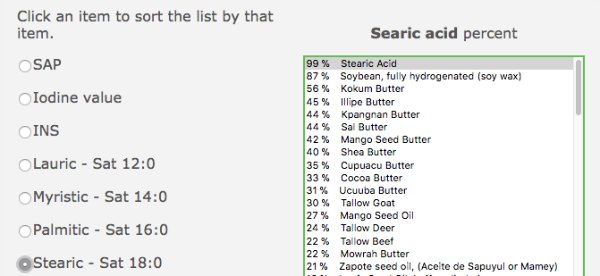
What stearic fatty acids number should a dual lye shave soap recipe contain?
Ideally, your shave soap recipe should have a stearic acid number of at least 32. You can see the amount of stearic in your recipe, by checking the “Fatty Acids %” results box at Soapee. The soap in the example below has 36 beside ‘stearic acid’, so that tells me I should have enough for a good dense lather. (A stearic number in the 40’s is excellent.)
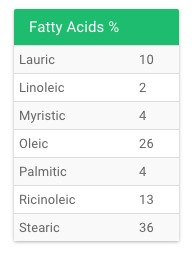
What ratio of sodium hydroxide and potassium hydroxide should be used in a shave soap?
60% potassium hydroxide (KOH) to 40% sodium hydroxide (NaOH) is a common ratio.
I developed my calendula shave soap recipe using Summer Bee Meadow’s advanced lye calculator with that 60/40 ratio. However, going by Soapee’s results, it reports those numbers are closer to a 50/50 ratio.
I liked how the soap turned out so left well enough alone, but be aware that lye calculators don’t always agree with each other!
What types of liquids can be used in a shaving soap recipe?
Some ideas include:
- Distilled water
- Aloe liquid
- Coconut milk
- Oat or almond milk
- Herbal tea (calendula, chamomile, etc)
You can also experiment with swapping part of the water amount for flat boiled beer or cow/goat milk, keeping in mind that the heat from cooking can scorch the natural sugars and affect color.
What additives can be included in shave soaps?
- A touch of Tussah silk dissolved in the lye solution will give the soap a silkier feel.
- Milk powders can be blended into the oils before adding the lye solution.
- Clay is not usually recommended because it can dull razors and can be drying. However, some shavers like it.
- Avoid herbal powders, colorants and exfoliants that will leave a gritty texture in the finished soap.
- However, coconut oil or any liquid oils can first be infused with herbs and flowers, then strained before using in the recipe.
Where can I find more dual lye shave soap recipes?
- Cedarwood & Coconut Milk Shave Soap (in my print book, Simple & Natural Soapmaking)
- Calendula Shave Soap Recipe (this website)
- Shaving Soap with Stearic Acid (Modern Soapmaking)
- Shaving Soap with Soy Wax (Modern Soapmaking)
- Tallow Shave Soap (Lovin Soap)
I hope you found this information helpful! Remember that every change you make to a shave soap recipe will impact the final soap, sometimes drastically, so be prepared to experiment many times over to get a soap you love.
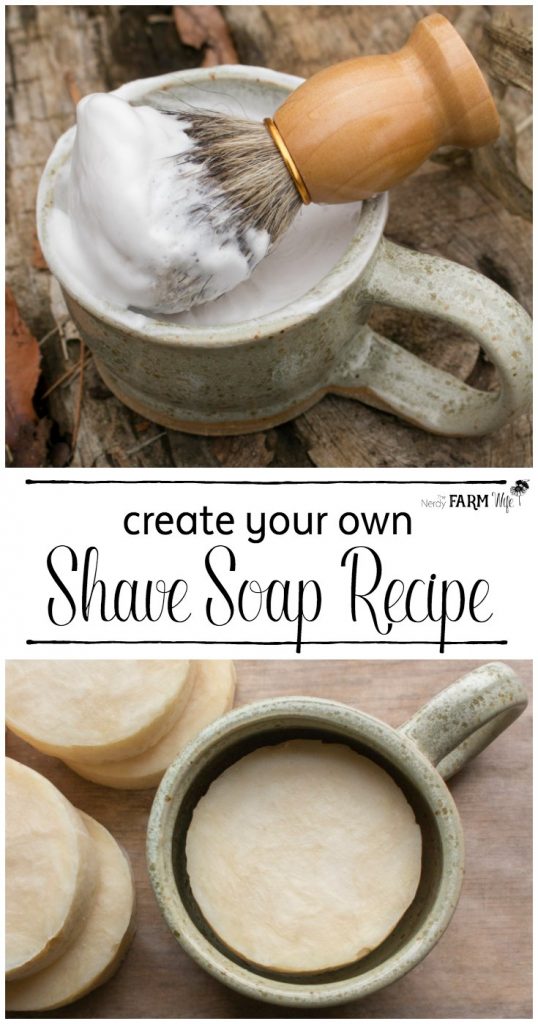

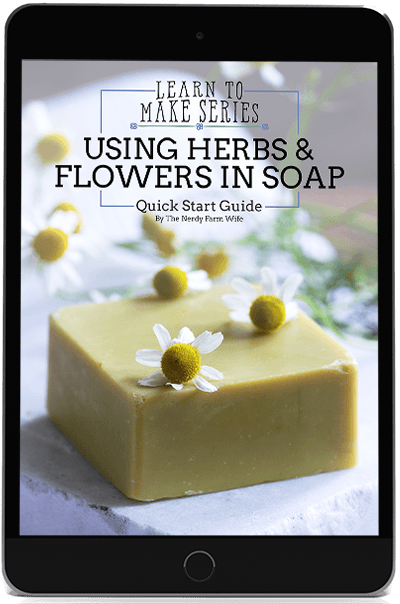

What is Kokum butter and what can I use in its place?
Hi Jean! Kokum butter is a very hard butter, kind of like cocoa butter. The Soap Queen has a great article on it: https://www.soapqueen.com/bath-and-body-tutorials/how-to-use-kokum-butter/
If you read the section in the article above “Which soapmaking ingredients are high in stearic acid?” – it gives a list of ingredients similarly high in stearic acid that you can use instead (stearic acid flakes and soy wax are your two best choices.) :)
i want to understand something. if we put water on the shaving soap before to use it ( for lather) …. do we need to dry the soap with a towel after to avoid it getting rancid ?
Hi Marie! It usually dries up pretty fast when exposed to the air, but you don’t want to leave it sitting in a puddle of water or anything. If it’s not in a mug, then you can store it on a draining soap dish. It won’t really go rancid as much as it will just kind of melt if it stays sitting in water. If it’s kept in a shaving mug, you could dab at the top with a towel to dry it some if you’d like; that could be a good idea!
how much do you et out of these ingredients?
Hi Anna Rosa! My calendula shave soap makes about 8 to 10 round soaps; it depends on how thick you cut them and the size of your mold. :)
Hi Jan,
Could you also make a shaving soap using kokum butter dual lye but cold process?
Thank you very much!
Hi Laura! Because of the high amount of stearic acid in the recipe, shave soap is prone to seizing up easily – which is why it’s hot processed. You could definitely make it cold process, there’s just a high chance it might get too thick to work with too fast. You could always try a small test batch though & see how it goes! :)
This is all great information! thanks so much! I’ve not had very much luck with shave soap, but will keep trying as you’ve inspired me to not give up :)
Hi Cindy, Good luck with your shave-soap-making adventures!
I found them tricky to get the hang of too, since little changes to the recipe or how you cook can really change things up!
Why such a high water to lye ratio? I know hot process requires a lot more liquid due to the cook but 5 to 1 seems unusually high. Most shave soap recipes I have seen are somewhere in the range of 3 or 3.5 to 1 water to lye ratio.
Hi Christian! I wonder if you’re seeing cold or hot process shave soap recipes made with just sodium hydroxide? That would be normal to have a lower amount of water.
For dual lye soaps – you need extra because of the potassium hydroxide, but also because dual lye shave formulas have a really high amount of stearic acid. The extra water gives you plenty of time to work with the soap.
If you check the example recipes I link to in this article, they all have at least 5x the amount of water than lye (one has about 7x!)
I don’t know if it’s a hard and fast rule though, but more like a recommended practice. The great thing about soapmaking is that there’s plenty of room to experiment and do things differently if you’d like! ?